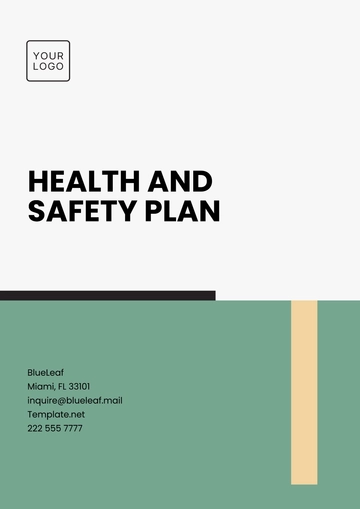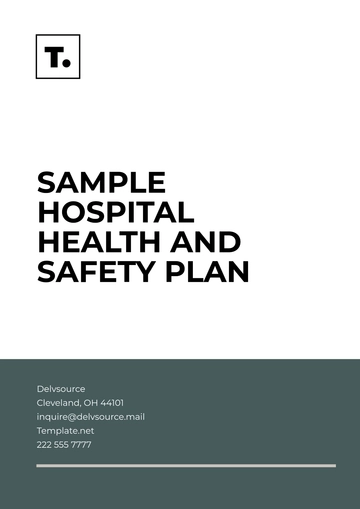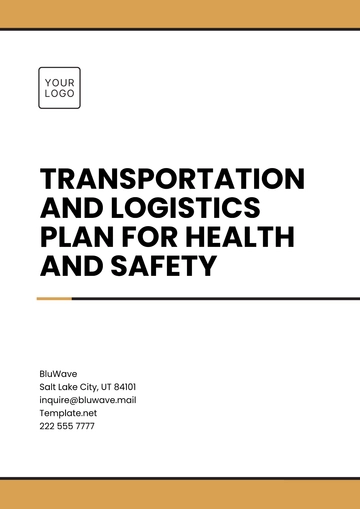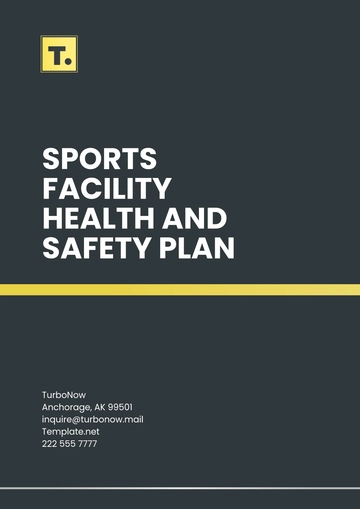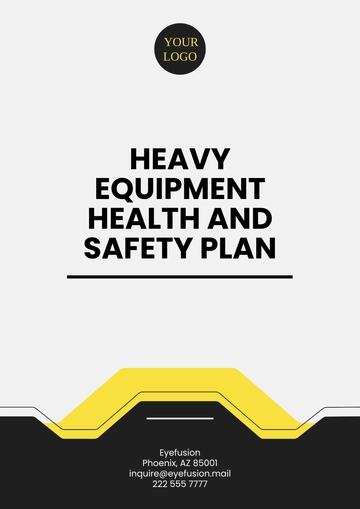Free Safety Compliance Plan

Date: [Date]
Prepared By: [Your Name]
I. Introduction
The purpose of this Safety Compliance Plan is to ensure a safe working environment, comply with all local, state, and federal safety regulations, and minimize risks associated with workplace hazards. This plan outlines the steps and procedures for implementing safety protocols, ensuring the well-being of all employees, and maintaining compliance with safety regulations.
II. Purpose
The purpose of this plan is to:
Establish a comprehensive safety program.
Ensure compliance with applicable workplace safety laws and regulations.
Identify potential hazards and implement preventive measures.
Promote a safety-first culture among employees.
Reduce accidents, injuries, and property damage.
III. Scope
This plan applies to all employees, contractors, and visitors at [Company Name] working on-site and in the office environment. It covers:
Identification and assessment of workplace hazards.
Corrective actions and control measures.
Emergency response protocols.
Training and awareness programs.
Record-keeping for compliance verification.
IV. Safety Compliance Criteria
1. Regulatory Compliance
Adhere to OSHA (Occupational Safety and Health Administration) standards and other relevant local and state laws.
Conduct regular audits to ensure compliance with safety laws.
Maintain records of safety inspections, reports, and certifications.
2. Hazard Identification and Risk Assessment
Regularly identify potential workplace hazards, including physical, chemical, electrical, and ergonomic risks.
Perform risk assessments and implement corrective actions to mitigate identified risks.
3. Safety Training and Awareness
Provide mandatory safety training to all employees, including emergency response, fire safety, equipment usage, and first aid.
Conduct refresher training at regular intervals.
Create safety awareness programs and communication channels to reinforce safety best practices.
4. Personal Protective Equipment (PPE)
Provide appropriate PPE such as gloves, helmets, eye protection, and safety shoes based on job requirements.
Ensure employees are trained on how to use and maintain PPE properly.
5. Emergency Preparedness and Response
Develop and implement emergency response procedures for fire, natural disasters, chemical spills, and workplace accidents.
Conduct regular drills and ensure all employees are aware of emergency exits, evacuation routes, and first-aid stations.
Designate emergency response teams and provide them with specialized training.
6. Incident Reporting and Investigation
Establish a procedure for reporting safety incidents, near misses, and injuries.
Investigate incidents thoroughly and take corrective actions to prevent reoccurrence.
Maintain incident records for internal and regulatory review.
7. Health and Safety Inspections
Conduct regular safety inspections and audits of all work areas.
Ensure equipment is properly maintained and meets safety standards.
Identify areas where safety improvements are needed and take corrective action.
V. Roles and Responsibilities
1. Management
Ensure resources are allocated for safety compliance and program implementation.
Promote a safety-first culture and lead by example.
Ensure all employees are trained and informed about safety procedures.
2. Safety Officer
Oversee the implementation of the Safety Compliance Plan.
Conduct safety audits and inspections.
Coordinate safety training and emergency drills.
Report safety performance and issues to management.
3. Employees
Follow all safety protocols and procedures.
Report hazards, accidents, and unsafe practices to supervisors.
Participate in safety training and awareness programs.
VI. Evaluation and Monitoring
Safety Audits: Conduct regular safety audits and inspections to ensure compliance with the plan.
Performance Metrics: Track safety-related metrics such as accident rates, near misses, and response times.
Continuous Improvement: Review safety policies annually and update them based on new regulations or findings from audits.
VII. Conclusion
This Safety Compliance Plan is essential to maintaining a safe and compliant workplace. By following these procedures and continuously evaluating safety practices, [Company Name] aims to reduce risks and ensure a healthy environment for all employees. Regular training, audits, and communication will be key to the plan's success and will help achieve long-term safety goals.
- 100% Customizable, free editor
- Access 1 Million+ Templates, photo’s & graphics
- Download or share as a template
- Click and replace photos, graphics, text, backgrounds
- Resize, crop, AI write & more
- Access advanced editor
Ensure workplace safety and regulatory compliance with the Safety Compliance Plan Template offered by Template.net. This customizable, downloadable, and printable template simplifies creating a comprehensive compliance plan tailored to your needs. Effortlessly editable in our AI Editor Tool, it’s perfect for maintaining safety standards while saving time and effort. Start planning smarter today!
You may also like
- Finance Plan
- Construction Plan
- Sales Plan
- Development Plan
- Career Plan
- Budget Plan
- HR Plan
- Education Plan
- Transition Plan
- Work Plan
- Training Plan
- Communication Plan
- Operation Plan
- Health And Safety Plan
- Strategy Plan
- Professional Development Plan
- Advertising Plan
- Risk Management Plan
- Restaurant Plan
- School Plan
- Nursing Home Patient Care Plan
- Nursing Care Plan
- Plan Event
- Startup Plan
- Social Media Plan
- Staffing Plan
- Annual Plan
- Content Plan
- Payment Plan
- Implementation Plan
- Hotel Plan
- Workout Plan
- Accounting Plan
- Campaign Plan
- Essay Plan
- 30 60 90 Day Plan
- Research Plan
- Recruitment Plan
- 90 Day Plan
- Quarterly Plan
- Emergency Plan
- 5 Year Plan
- Gym Plan
- Personal Plan
- IT and Software Plan
- Treatment Plan
- Real Estate Plan
- Law Firm Plan
- Healthcare Plan
- Improvement Plan
- Media Plan
- 5 Year Business Plan
- Learning Plan
- Marketing Campaign Plan
- Travel Agency Plan
- Cleaning Services Plan
- Interior Design Plan
- Performance Plan
- PR Plan
- Birth Plan
- Life Plan
- SEO Plan
- Disaster Recovery Plan
- Continuity Plan
- Launch Plan
- Legal Plan
- Behavior Plan
- Performance Improvement Plan
- Salon Plan
- Security Plan
- Security Management Plan
- Employee Development Plan
- Quality Plan
- Service Improvement Plan
- Growth Plan
- Incident Response Plan
- Basketball Plan
- Emergency Action Plan
- Product Launch Plan
- Spa Plan
- Employee Training Plan
- Data Analysis Plan
- Employee Action Plan
- Territory Plan
- Audit Plan
- Classroom Plan
- Activity Plan
- Parenting Plan
- Care Plan
- Project Execution Plan
- Exercise Plan
- Internship Plan
- Software Development Plan
- Continuous Improvement Plan
- Leave Plan
- 90 Day Sales Plan
- Advertising Agency Plan
- Employee Transition Plan
- Smart Action Plan
- Workplace Safety Plan
- Behavior Change Plan
- Contingency Plan
- Continuity of Operations Plan
- Health Plan
- Quality Control Plan
- Self Plan
- Sports Development Plan
- Change Management Plan
- Ecommerce Plan
- Personal Financial Plan
- Process Improvement Plan
- 30-60-90 Day Sales Plan
- Crisis Management Plan
- Engagement Plan
- Execution Plan
- Pandemic Plan
- Quality Assurance Plan
- Service Continuity Plan
- Agile Project Plan
- Fundraising Plan
- Job Transition Plan
- Asset Maintenance Plan
- Maintenance Plan
- Software Test Plan
- Staff Training and Development Plan
- 3 Year Plan
- Brand Activation Plan
- Release Plan
- Resource Plan
- Risk Mitigation Plan
- Teacher Plan
- 30 60 90 Day Plan for New Manager
- Food Safety Plan
- Food Truck Plan
- Hiring Plan
- Quality Management Plan
- Wellness Plan
- Behavior Intervention Plan
- Bonus Plan
- Investment Plan
- Maternity Leave Plan
- Pandemic Response Plan
- Succession Planning
- Coaching Plan
- Configuration Management Plan
- Remote Work Plan
- Self Care Plan
- Teaching Plan
- 100-Day Plan
- HACCP Plan
- Student Plan
- Sustainability Plan
- 30 60 90 Day Plan for Interview
- Access Plan
- Site Specific Safety Plan
